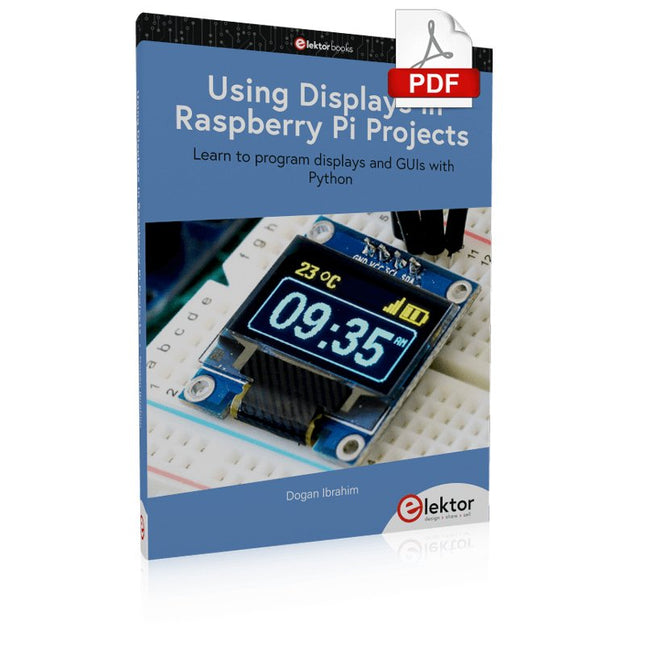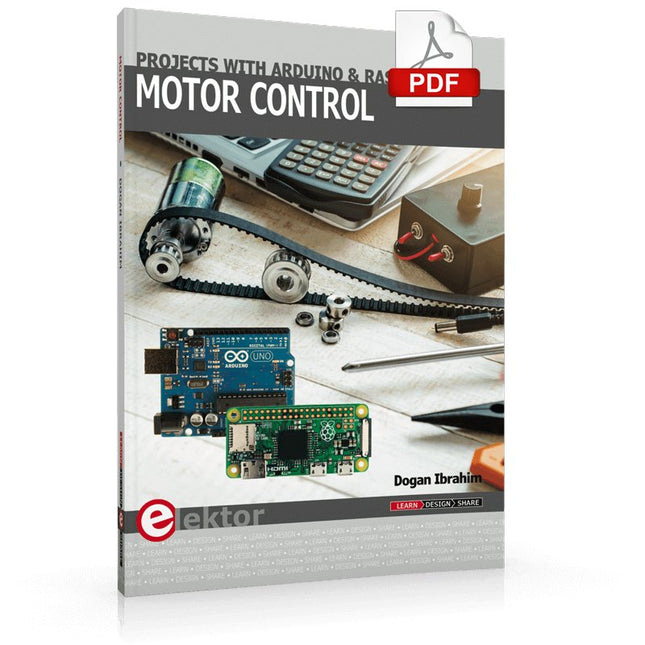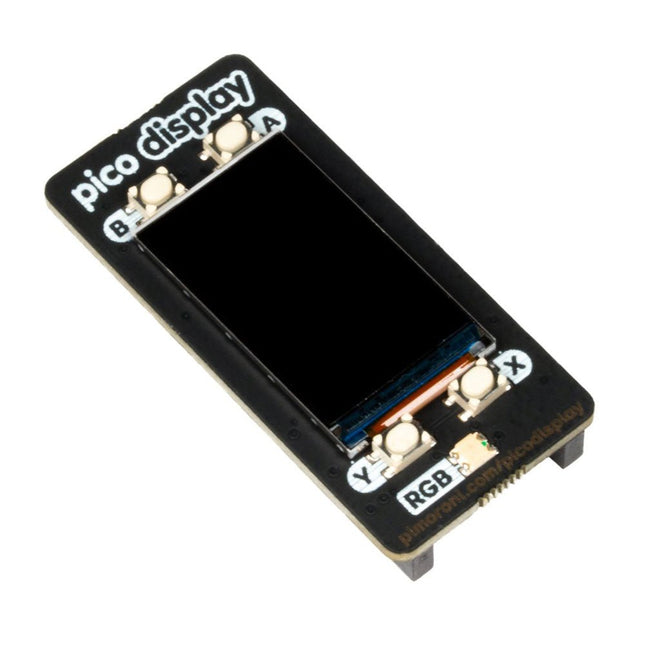Suchergebnisse für "using OR displays OR in OR raspberry OR pi OR projects"
-

Elektor Digital Using Displays in Raspberry Pi Projects (E-book)
Learn to program displays and GUIs with Python This book is about Raspberry Pi 4 display projects. The book starts by explaining how to install the latest Raspbian operating system on an SD card, and how to configure and use the GPIO ports. The core of the book explains the following topics in simple terms with fully tested and working example projects: Simple LED projects Bar graph LED projects Matrix LED projects Bitmap LED projects LED strips LCDs OLED displays E-paper displays TFT displays 7-inch touch screen GUI Programming with Tkinder One unique feature of this book is that it covers almost all types of display that readers will need to use in their Raspberry Pi based projects. The operation of each project is fully given, including block diagrams, circuit diagrams, and commented full program listings. It is therefore an easy task to convert the given projects to run on other popular platforms, such as Arduino or PIC microcontrollers. Python program listings of all Raspberry Pi projects developed in this book are available for download at Elektor.com. Readers can use these programs in their projects. Alternatively, they can modify the programs to suit their applications.
€ 32,95
Mitglieder € 26,36
-

Elektor Digital Hardware Projects for Raspberry Pi (E-book)
The Raspberry Pi is a $35 credit-card sized computer with many applications, such as in desktop computing, audio and video playback, and as a controller in many industrial, commercial and domestic applications. This book is about the Raspberry Pi computer and its use in control applications. The book explains in simple terms, with examples, how to configure the RPi, how to install and use the Linux operating system, how to write programs using the Python programming language and how to develop hardware based projects. The book starts with an introduction to the Raspberry Pi computer and covers the topics of purchasing all the necessary equipment and installing/using the Linux operating system in command mode. Use of the user-friendly graphical desktop operating environment is explained using example applications. The RPi network interface is explained in simple steps and demonstrates how the computer can be accessed remotely from a desktop or a laptop computer. The remaining parts of the book cover the Python programming language, hardware development tools, hardware interface details, and RPi based hardware projects. All the 23 projects given in the book have been tested and are working. The following headings are given for each project: Project title Project description Project block diagram Project circuit diagram Project program description using the Program Description Language (PDL) Complete program listing Description of the program The book is ideal for self-study, and is intended for electronic/electrical engineering students, practising engineers, research students, and hobbyists.
€ 34,95
Mitglieder € 27,96
-

Elektor Publishing Explore the Raspberry Pi in 45 Electronics Projects (3rd Edition)
3rd Edition – Fully updated for Raspberry Pi 4 The Raspberry Pi is a very cheap but complete computer system that allows all sorts of electronics parts and extensions to be connected. This book addresses one of the strongest aspects of the Raspberry Pi: the ability to combine hands-on electronics and programming. Combine hands-on electronics and programming After a short introduction to the Raspberry Pi you proceed with installing the required software. The SD card that can be purchased in conjunction with this book contains everything to get started with the Raspberry Pi. At the side of the (optional) Windows PC, software is used which is free for downloading. The book continues with a concise introduction to the Linux operating system, after which you start programming in Bash, Python 3 and Javascript. Although the emphasis is on Python, the coverage is brief and to the point in all cases – just enabling you to grasp the essence of all projects and start adapting them to your requirements. All set, you can carry on with fun projects. The book is ideal for self-study No fewer than 45 exciting and compelling projects are discussed and elaborated in detail. From a flashing lights to driving an electromotor; from processing and generating analog signals to a lux meter and a temperature control. We also move to more complex projects like a motor speed controller, a web server with CGI, client-server applications and Xwindows programs. Each project has details of the way it got designed that way The process of reading, building, and programming not only provides insight into the Raspberry Pi, Python, and the electronic parts used, but also enables you to modify or extend the projects any way you like. Also, feel free to combine several projects into a larger design.
€ 39,95
Mitglieder € 35,96
-

Elektor Digital Motor Control - Projects with Arduino & Raspberry Pi (E-book)
This book is about DC electric motors and their use in Arduino and Raspberry Pi Zero W based projects. The book includes many tested and working projects where each project has the following sub-headings: Title of the project Description of the project Block diagram Circuit diagram Project assembly Complete program listing of the project Full description of the program The projects in the book cover the standard DC motors, stepper motors, servo motors, and mobile robots. The book is aimed at students, hobbyists, and anyone else interested in developing microcontroller based projects using the Arduino Uno or the Raspberry Pi Zero W. One of the nice features of this book is that it gives complete projects for remote control of a mobile robot from a mobile phone, using the Arduino Uno as well as the Raspberry Pi Zero W development boards. These projects are developed using Wi-Fi as well as the Bluetooth connectivity with the mobile phone. Readers should be able to move a robot forward, reverse, turn left, or turn right by sending simple commands from a mobile phone. Full program listings of all the projects as well as the detailed program descriptions are given in the book. Users should be able to use the projects as they are presented, or modify them to suit to their own needs.
€ 29,95
Mitglieder € 23,96
-

Elektor Digital Raspberry Pi 3 - Basic to Advanced Projects (E-book)
This ebook is about the Raspberry Pi 3 computer and its use in various control and monitoring applications. The book explains in simple terms and with tested and working example projects, how to configure the Raspberry Pi 3 computer, how to install and use the Linux operating system, and how to write hardware based applications programs using the Python programming language. The nice feature of this book is that it covers many Raspberry Pi 3 based hardware projects using the latest hardware modules such as the Sense HAT, Swiss Pi, MotoPi, Camera module, and many other state of the art analog and digital sensors. An important feature of the Raspberry Pi 3 is that it contains on-board Bluetooth and Wi-Fi modules. Example projects are given in the book on using the Wi-Fi and the Bluetooth modules to show how real-data can be sent to the Cloud using the Wi-Fi module, and also how to communicate with an Android based mobile phone using the Bluetooth module. The book is ideal for self-study, and is intended for electronic/electrical engineering students, practising engineers, research students, and for hobbyists. It is recommended that the book should be followed in the given Chapter order. Over 30 projects are given in the book. All the projects in the book are based on the Python programming language and they have been fully tested. Full program listings of every project are given in the book with comments and full descriptions. Experienced programmers should find it easy to modify and update the programs to suit their needs. The following sub-headings are given for each project to make it as easy as possible for the readers to follow the projects: Project title Description Aim of the project Raspberry Pi type Block diagram Circuit diagram Program listing
€ 29,95
Mitglieder € 23,96
-

Pimoroni Pimoroni Raspberry Pi Pico Display-Paket
Mit Pico Display können Sie einen Pico in ein kompaktes Benutzerschnittstellengerät für ein größeres Projekt verwandeln, das in der Lage ist, Anweisungen zu geben, Messwerte anzuzeigen und sogar ausgefeilte verschachtelte Menüs zu integrieren. Wenn Sie Ihren Pico lieber als eigenständiges Gerät verwenden möchten, können Sie eine kleine rotierende Diashow mit Bildern erstellen, wunderschöne Grafiken aus Sensordaten anzeigen oder Ihr eigenes Textabenteuerspiel in Tamagotchi- oder Streichholzschachtelgröße erstellen. Merkmale 1,14-Zoll-IPS-LCD-Bildschirm mit 240 x 135 Pixeln 4 x taktile Tasten RGB-LED Vorgelötete Buchsenleisten zum Anbringen an Pico Kompatibel mit Raspberry Pi Pico. Komplett montiert Kein Löten erforderlich (solange Ihr Pico über Stiftleisten verfügt). Abmessungen: ca. 53 x 25 x 9 mm (L x B x H) Bildschirmnutzfläche: ca. 25 x 15 mm (L x B) C/C++- und MicroPython-Bibliotheken
€ 19,95
Mitglieder € 17,96
-

Raspberry Pi Foundation Raspberry Pi DAC+
Der Raspberry Pi DAC+ (früher bekannt als IQaudio DAC+) ist ein leistungsstarker Audio-HAT für jeden Raspberry Pi mit 40-poligem GPIO-Anschluss. Ausgestattet mit dem PCM5122 DAC von Texas Instruments liefert er kristallklaren analogen Stereo-Sound über zwei Cinch-Anschlüsse. Es wird keine externe Stromversorgung benötigt – der DAC+ wird direkt an den GPIO-Anschluss des Raspberry Pi angeschlossen, ohne dass Lötarbeiten oder Kabel erforderlich sind. Features Betriebs-LED Analoger Audioausgang (0-2 V RMS) über Stereo-Panel Cinch-Buchsen mit MUTE-Signal (Kopfhörererkennung) Dedizierter Kopfhörerverstärker, Ausgang über 3,5-mm-Panel-Hohlstecker 40-poliger GPIO-Anschluss mit Durchgang Schreibschutz für HAT-EEPROM Downloads Datasheet
€ 29,95€ 19,95
Mitglieder identisch
-

Raspberry Pi Foundation Offizielle Raspberry Pi US-Tastatur (weiß/rot)
Bei der offiziellen Tastatur und dem Hub des Raspberry Pi handelt es sich um eine standardmäßige US-Tastatur mit 78 Tasten, die über drei zusätzliche USB 2.0-Anschlüsse vom Typ A verfügt, um andere Peripheriegeräte mit Strom zu versorgen. Die Tastatur ist in verschiedenen Sprach-/Länderoptionen verfügbar, wie unten beschrieben. US-Tastatur mit 78 Tasten Drei USB 2.0 Typ-A-Anschlüsse zur Stromversorgung anderer Peripheriegeräte Automatische Erkennung der Tastatursprache USB-Typ-A-zu-Micro-USB-Typ-B-Kabel zum Anschluss an einen kompatiblen Computer im Lieferumfang enthalten Ergonomisches Design für komfortable Nutzung Kompatibel mit allen Raspberry Pi-Produkten
€ 17,95
Mitglieder identisch
-

Elektor Publishing Multitasking with Raspberry Pi
Multitasking und Multiprocessing sind zu einem sehr wichtigen Thema in mikrocontrollerbasierten Systemen geworden, insbesondere in komplexen kommerziellen, häuslichen und industriellen Automatisierungsanwendungen. Mit zunehmender Komplexität von Projekten werden immer mehr Funktionalitäten von den Projekten gefordert. Solche Projekte erfordern die Verwendung mehrerer miteinander verbundener Aufgaben, die auf demselben System ausgeführt werden und die verfügbaren Ressourcen wie CPU, Speicher und Eingabe-Ausgabe-Ports gemeinsam nutzen. Infolgedessen hat die Bedeutung von Multitasking-Operationen in Mikrocontroller-basierten Anwendungen in den letzten Jahren stetig zugenommen. Viele komplexe Automatisierungsprojekte nutzen mittlerweile eine Art Multitasking-Kernel. Dieses Buch ist projektbasiert und sein Hauptziel besteht darin, die grundlegenden Funktionen des Multitasking mit der Programmiersprache Python 3 auf dem Raspberry Pi zu vermitteln. Das Buch stellt viele vollständig getestete Projekte bereit, die die Multitasking-Module von Python verwenden. Jedes Projekt wird vollständig und detailliert beschrieben. Für jedes Projekt werden vollständige Programmlisten bereitgestellt. Der Leser soll die Möglichkeit haben, die Projekte so zu nutzen, wie sie sind, oder sie an ihre eigenen Bedürfnisse anzupassen. Die folgenden Python-Multitasking-Module wurden beschrieben und in den Projekten verwendet: Gabel Faden Einfädeln Unterprozess Mehrfachverarbeitung Das Buch umfasst einfache Multitasking-Projekte wie die unabhängige Steuerung mehrerer LEDs bis hin zu komplexeren Multitasking-Projekten wie Ein-/Aus-Temperaturregelung, Ampelsteuerung, 2-stelliger und 4-stelliger 7-Segment-LED-Ereigniszähler, Reaktionstimer und Schrittmotor Steuerung, tastaturbasierte Projekte, Parkplatzsteuerung und vieles mehr. Die grundlegenden Multitasking-Konzepte wie Prozesssynchronisation, Prozesskommunikation und Speicherfreigabetechniken wurden in Projekten zu Ereignisflags, Warteschlangen, Semaphoren, Werten usw. beschrieben.
€ 39,95
Mitglieder € 35,96
-

Elektor Digital Explore the Raspberry Pi in 45 Electronics Projects (3rd Edition | E-book)
3rd Edition – Fully updated for Raspberry Pi 4 The Raspberry Pi is a very cheap but complete computer system that allows all sorts of electronics parts and extensions to be connected. This book addresses one of the strongest aspects of the Raspberry Pi: the ability to combine hands-on electronics and programming. Combine hands-on electronics and programming After a short introduction to the Raspberry Pi you proceed with installing the required software. The SD card that can be purchased in conjunction with this book contains everything to get started with the Raspberry Pi. At the side of the (optional) Windows PC, software is used which is free for downloading. The book continues with a concise introduction to the Linux operating system, after which you start programming in Bash, Python 3 and Javascript. Although the emphasis is on Python, the coverage is brief and to the point in all cases – just enabling you to grasp the essence of all projects and start adapting them to your requirements. All set, you can carry on with fun projects. The book is ideal for self-study No fewer than 45 exciting and compelling projects are discussed and elaborated in detail. From a flashing lights to driving an electromotor; from processing and generating analog signals to a lux meter and a temperature control. We also move to more complex projects like a motor speed controller, a web server with CGI, client-server applications and Xwindows programs. Each project has details of the way it got designed that way The process of reading, building, and programming not only provides insight into the Raspberry Pi, Python, and the electronic parts used, but also enables you to modify or extend the projects any way you like. Also, feel free to combine several projects into a larger design.
€ 32,95
Mitglieder € 26,36
-

Raspberry Pi Foundation Raspberry Pi Build HAT
Bauen Sie robuste, intelligente Maschinen, die die Rechenleistung des Raspberry Pi mit LEGO-Komponenten kombinieren. Der Raspberry Pi Build HAT bietet vier Anschlüsse für LEGO Technic Motoren und Sensoren aus dem SPIKE Portfolio. Zu den verfügbaren Sensoren gehören ein Abstandssensor, ein Farbsensor und ein vielseitiger Kraftsensor. Die Winkelmotoren sind in verschiedenen Größen erhältlich und verfügen über integrierte Encoder, die ihre Position abfragen können. Der Build HAT passt auf alle Raspberry Pi-Computer mit einem 40-Pin-GPIO-Header, einschließlich – mit der Hinzufügung eines Flachbandkabels oder eines anderen Erweiterungsgeräts – Raspberry Pi 400. Angeschlossene LEGO Technic-Geräte können neben Standard-Raspberry-Pi-Zubehör problemlos in Python gesteuert werden wie zum Beispiel ein Kameramodul. Merkmale Steuert bis zu 4 Motoren und Sensoren Versorgt den Raspberry Pi mit Strom (bei Verwendung mit einem geeigneten externen Netzteil) Einfache Verwendung von Python auf dem Raspberry Pi
€ 29,95€ 19,95
Mitglieder identisch
-

Raspberry Pi Foundation Raspberry Pi Pico 2
Der Raspberry Pi Pico 2 ist ein neues Mikrocontroller-Board der Raspberry Pi Foundation, basierend auf dem RP2350. Es verfügt über eine höhere Kerntaktrate, doppelt so viel On-Chip-SRAM, doppelt so viel On-Board-Flash-Speicher, leistungsstärkere Arm-Kerne, optionale RISC-V-Kerne, neue Sicherheitsfunktionen und verbesserte Schnittstellenfunktionen. Der Raspberry Pi Pico 2 bietet eine deutliche Steigerung der Leistung und Funktionen und behält gleichzeitig die Hardware- und Softwarekompatibilität mit früheren Mitgliedern der Raspberry Pi Pico-Serie bei. Der RP2350 bietet eine umfassende Sicherheitsarchitektur rund um Arm TrustZone für Cortex-M. Es umfasst signiertes Booten, 8 KB Antifuse-OTP für die Schlüsselspeicherung, SHA-256-Beschleunigung, einen Hardware-TRNG und schnelle Glitch-Detektoren. Die einzigartige Dual-Core- und Dual-Architektur-Fähigkeit des RP2350 ermöglicht Benutzern die Wahl zwischen einem Paar ARM Cortex-M33-Kernen nach Industriestandard und einem Paar Hazard3 RISC-V-Kernen mit offener Hardware. Der Raspberry Pi Pico 2 ist in C/C++ und Python programmierbar und wird durch eine ausführliche Dokumentation unterstützt. Er ist das ideale Mikrocontroller-Board sowohl für Enthusiasten als auch für professionelle Entwickler. Technische Daten CPU Dual Arm Cortex-M33 oder Dual RISC-V Hazard3 Prozessoren bei 150 MHz Speicher 520 KB On-Chip-SRAM; 4 MB integrierter QSPI-Flash Schnittstellen 26 Mehrzweck-GPIO-Pins, darunter 4, die für AD verwendet werden können Peripheriegeräte 2x UART 2x SPI-Controller 2x I²C-Controller 24x PWM-Kanäle 1x USB 1.1-Controller und PHY, mit Host- und Geräteunterstützung 12x PIO-Zustandsmaschinen Eingangsspannung 1,8-5,5 V DC Abmessungen 21 x 51 mm Downloads Datasheet (Pico 2) Datasheet (RP2350)
€ 5,95
Mitglieder identisch











